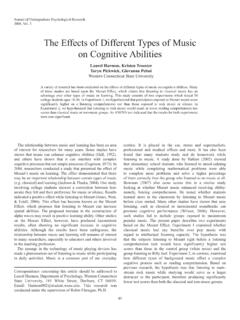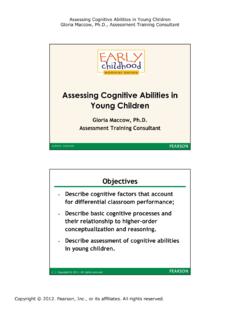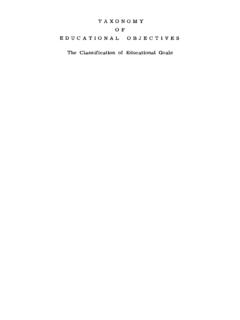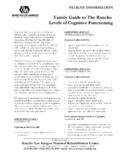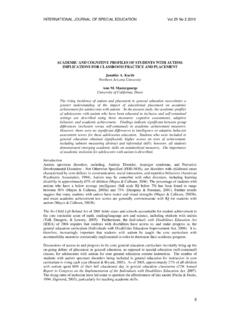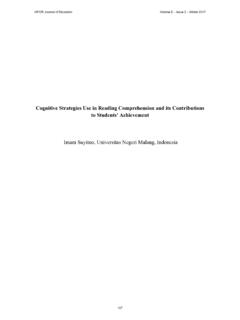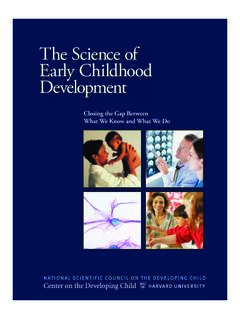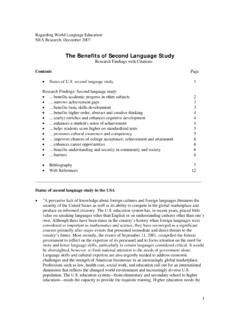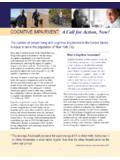Transcription of Appendix 4: Cognitive Testing Interview Guide
1 1 Appendix 4: Cognitive Testing Interview Guide What is Cognitive Testing ? How is it useful? The primary purpose of Cognitive Testing is to investigate how well questions perform when asked of survey respondents, that is, if respondents understand the question correctly and if they can provide accurate answers. Cognitive Testing insures that a survey question successfully captures the scientific intent of the question and, at the same time, makes sense to respondents. Questions that are misunderstood by respondents or that are difficult to answer can be improved prior to fielding the survey, thereby increasing the overall quality of survey data. Additionally, once survey data has been collected, Cognitive Testing results can provide useful information f or users by documenting potential sources of response error as well as providing a richer understanding of the type of data that has been collected.
2 In evaluating a question s performance, Cognitive Testing examines the question-response process (a process that can be conceptualized by four stages: comprehension, retrieval, judgment and response) and considers the degree of difficulty respondents experience as they formulate an accurate response to the question. In each of the four stages, various types of response errors can occur. The following chart outlines some of those problems: Cognitive Model of Question-Response Cognitive Stage Definition Response Errors/Question Problems Stage 1 Comprehension Respondent interprets the question Unknown terms, Ambiguous concepts, Long and overly complex Stage 2 Retrieval Respondent searches memory for relevant information Recall difficulty Stage 3 Judgment Respondent evaluates and/or estimates response Biased or sensitive, Estimation difficulty Stage 4 Response Respondent provides information in the format requested Incomplete response options Typically, Cognitive Testing is performed by conducting in-depth, semi-structured interviews with a small number of respondents similar to those targeted in the survey.
3 The interviews are designed to elicit respondents thought processes when answering the tested question, specifically, how they understood a question and how they arrived at their answer. Data from Cognitive interviews are qualitative, and analysis of those interviews can indicate the sources of potential response error as well as various interpretations of the question. By conducting a comparative analysis of Cognitive interviews, it is possible to identify patterns of error and patterns of interpretation across groups of people. This type of analysis is especially useful when examining the comparability of measures, for example, between countries or between social classes. The differences between Cognitive Testing and field Testing are important to understand.
4 Unlike a field test, the primary objective of a Cognitive test is not to produce statistical data that can be generalized to an entire population. Rather, the objective of Cognitive Testing is to provide an in-depth exploration of particular concepts, processes and patterns of interpretation. As a result, Cognitive Testing draws upon a much smaller, purposive sample. Finally, because the Interview involves examining what a respondent is actually thinking or feeling when 2 answering a question, the Cognitive Interview can seem somewhat personal or even strange to respondents, and it is important to make this clear to respondents when they have volunteered for a Cognitive Interview . Testing the Washington Group questions: What are the goals?
5 What are the challenges? The primary goal of Cognitive Testing is to Determine whether questions are being interpreted as intended. That is, if they are capturing aspects of the selected functional domains Determine whether questions are interpreted consistently across countries and among subpopulations Challenges for conducting the Cognitive test Interviewers may have little or no training Interviewers may have no understanding of Cognitive methods Multiple languages Multiple cultures Variety of levels of country resources Given the challenges, the Cognitive Testing protocol must: Be a more structured Interview Guide than traditional Cognitive interviewing Provide very simple instructions Contain few skip patterns Rely on quantitative data and analysis The final protocol, though unconventional because it is not qualitative, is based on the principles of traditional Cognitive Testing and is designed to collect information regarding the question response process, including patterns of interpretation, evaluation and decision-making patterns, as well as potential response error.
6 Instructions for conducting the Washington Group Cognitive Test In comparison to the field test, few resources are required to conduct the Cognitive test. The Cognitive test can be conducted in the time of approximately one week and requires only a few interviewers. The following steps outline the procedures to conduct the Cognitive test of the Washington Group questions: 1. Translating the Cognitive Test Questionnaire It is important to modify the Cognitive test questionnaire specifically for your country and the respondents that you will be interviewing. The Cognitive test questionnaire was initially developed in English in the United States. A Spanish version of the questionnaire was also produced to test the protocol among Spanish-speaking respondents in the United States.
7 It was then pilot tested in Mexico City. In the pilot test, however, the translated questionnaire did not perform in Mexico as it did in the United States. Even though both tests were performed in Spanish, cultural and linguistic differences in the two countries generated significant differences in the terms and meanings of the questions. Consequently, the Spanish questionnaire needed to be modified specifically for the country of Mexico. To produce an appropriate translation of the Cognitive test questionnaire for your country, have two or three bilingual speakers translate and review the questionnaire. In drafting a translation, refer to the Question Specifications that describe the purpose of each question.
8 Reviewers should work independently, but then 3 meet to discuss their impressions and reconcile discrepancies. This small group approach produces a more accurate translation than the subjective opinion of a single translator or by conducting a forward/back translation. In the end, the translated version of the questionnaire should be conceptually identical to the original version. That is, the ideas and meanings of the questions must be conveyed in the way that respondents will understand them as originally intended. The questionnaire should not simply be a word-for-word translation of the original protocol. If you have any questions regarding the meaning or intention in the original questionnaire, please contact the Washington Group secretariat.
9 Additionally, be sure to document and report all changes that are made to the protocol in the translation process. 2. Selecting and Training Interviewers The Cognitive test questionnaire was developed to be easily administered. However, if it is possible to select interviewers who understand the purpose of the test and who have experience conducting survey interviews, the data collected will likely be of higher quality. The number of interviewers that are required will depend on the available resources and the number of interviews that you want to conduct. It is possible to conduct all of the interviews yourself. Or, you can use as many as 20 interviewers to conduct only four or five interviews each. To train interviewers, read through the questionnaire and refer to the interviewer instructions that appear below.
10 Be sure that interviewers understand the purpose of the Interview as well as the various components of the Interview Guide . It is critical that interviewers understand that they are not to correct or help the respondent to answer questions, especially the core questions which are being tested. The interviewer must read the question exactly as it is written and then record the answer as it is reported by the respondent. If the respondent cannot answer the question, the interviewer should record don t know and then continue on to the next question. Interviewers should conduct a couple of practice interviews so that they become familiar with the questionnaire s skip patterns and are able to accurately record the interviewer coding questions.










